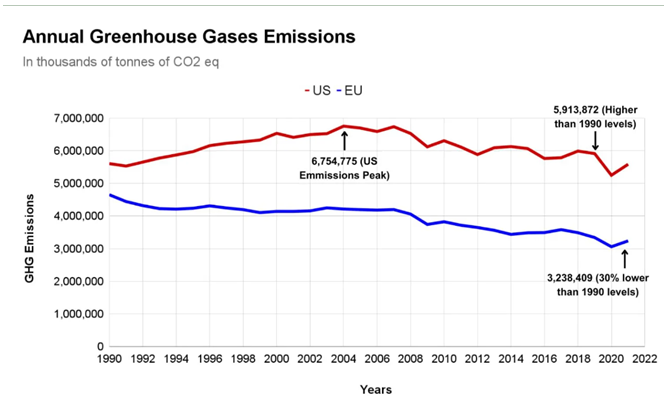

Context
United States has been one of the biggest laggards on climate action. Not only has it not cut down on its emissions so far, it has done little to meet its financial and technological obligations.
About
The United States' Lacklustre Climate Commitments: A Closer Look at COP28
- Loss and Damage Fund Contributions:
- UAE: $100 million
- Germany: $100 million
- France: Approximately $110 million
- Italy: Approximately $110 million
- United Kingdom: $60 million
- United States: $17.3 million
- Historical Emissions Responsibility:
- United States Share: The United States holds the largest share of historical emissions, over 20% of global carbon dioxide emissions since 1850.
- Historical Emissions: Despite China emitting more in the last 15 years, the U.S. still maintains a significant historical emissions burden.
|
Country |
Share of historical Emissions (1850-2021) in % |
|
US |
20.9 |
|
European Union |
11.8 |
|
China |
11.5 |
|
Brazil |
4.6 |
|
India |
3.3 |
|
Source: Study published in Nature, 2023 |
|
- Kyoto Protocol and Emission Reductions:
- Non ratification of Kyoto Protocol: The U.S. never ratified the Kyoto Protocol, failing to abide by assigned emissions reduction targets.
- The U.S collective contribution: By 2020, Annex-I countries collectively reduced net greenhouse gas emissions by about 25%, with the U.S. contributing only 0.4%.
- 2020 Emission Targets:
- The U.S. claims to have met its 2020 emission targets (17% reduction from 2005 baseline). The U.S. used a 2005 baseline, unlike most Annex-I countries using a 1990 baseline.
- Future Emission Reduction Targets:
- The U.S. promise: The U.S. promises a 50-52% reduction by 2030 from 2005 levels.
- IPCC recommendations:IPCC recommends a global emissions drop of at least 43% by 2030 from 2019 levels to achieve the 1.5-degree Celsius target.
6.Current Policies and Projections:
- UNFCCC assessment suggests the U.S. may achieve only about a 20% reduction from 2005 baseline by 2030.
- Inflation Reduction Act: The Inflation Reduction Act is crucial for the U.S. to meet the 50-52% reduction target.
7.Fossil Fuel Dependency:
- Largest Emitter: The U.S. remains the largest producer of fossil fuels, with over 80% of its energy needs met by oil, natural gas, and coal.
- Biased Criticism: Despite being a significant fossil fuel guzzler, the U.S. faces less criticism compared to countries like India.
- Climate Finance Contributions:
- Green Climate Fund (GCF): The U.S. commits $3 billion to the Green Climate Fund (GCF) for the next four years, the largest sum from any single country.
- Climate actions: GCF handles a small fraction of the funds required for climate actions, estimated to be trillions of dollars annually.
- Global Climate Finance Target:
- 100 billion Dollartarget: In 2009, the U.S. proposed a 100 billion Dollar per year target for climate finance by developed countries from 2020 onwards.
- Issues with target: Despite claims of reaching this target in 2022, concerns exist about double-counting, repurposing, and green washing.
10.Adaptation Funding Challenges:
- Adaptation Gap Report: The Adaptation Gap Report reveals a decline in funds for adaptation activities, contrary to the decision to double financial flows to adaptation in Glasgow.
- Global Goal on Adaptation: The United States played a role in excluding separate financial provisions for adaptation in the Global Goal on Adaptation decision at COP28.
Way Forward:
The United States' contributions to emission reductions, climate finance, and adaptation efforts are deemed insufficient, raising concerns about its commitment to addressing the global climate crisis.



